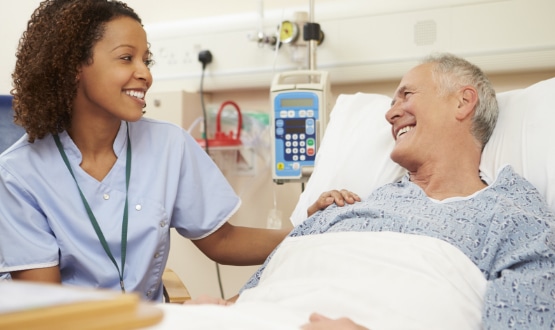How hospitals can use their wi-fi and bedside infrastructure to turbocharge innovation
- 18 April 2024

Matt O’Donovan, the chief executive of SPARK TSL, argues that trusts and health boards need to put their wi-fi and bedside units to work. And the company’s acquisition of Sentean Group and its Fusion Bedside platform gives them a new and unique digital transformation platform to drive quantifiable improvements in efficiency and patient engagement
NHS trusts and health boards have made a significant investment in wi-fi and bedside infrastructure. At the moment it is being used to deliver communication and entertainment services to patients and staff; but it has the potential to be used for much more.
Over the past year, SPARK TSL has been talking to IT, facilities and patient engagement leads about using this technology to deliver apps to the bedside that can improve efficiency and deliver a much better patient experience.
In round tables and one-to-one conversations, we have heard there is an urgent need to streamline the delivery of clinical, ‘hotel’ and meal services, and to get information about everything from treatment plans to discharge arrangements into the hands of patients in a cost-effective way.
That’s why we have just announced the acquisition of the Dutch company, Sentean Group, and its Fusion Bedside platform. Fusion Bedside integrates with core IT systems and offers trusts a platform on which to deliver the state-of-the-art healthcare and patient-centric apps their staff are crying out for.
From free wi-fi to patient activation
SPARK TSL has been integral to the development of the wi-fi and bedside infrastructure that the NHS has in place. We started working with a large London trust in 2005 and went on to develop SPARK Connect to help hospitals deliver free NHS wi-fi a decade later.
We also developed a SPARK Media package of live and on-demand TV, magazines, games and entertainment, with log-in screens that trusts can use to deliver additional information to users or to support their charities. In 2020, we became part of the Volaris Group, and the following year it acquired bedside unit provider Hospedia.
Hospedia is very well known in the NHS and – we’d be the first to admit – not always for good reasons. It took over the old Patient Line contract for bedside communications and entertainment, which was awarded on a ‘patient pays’ basis.
Our vision has been to move away from this outdated – and, we know, deeply unpopular – model and to encourage trusts to make these services ‘free at the point of delivery.’ At the same time, we have been talking to trusts about how they can make better use of the substantial infrastructure that sat behind the Hospedia units.
The trunking, wiring, and arms on which the units operated can be used to support modern communication and entertainment devices. We already offer trusts SPARK Horizon units that look like large iPads, and use the same kind of touch-screen technology.
But what’s more exciting is the innovation that can be delivered over these units, and the devices that staff and patients bring into hospital and connect to that free wi-fi. We are already working with organisations that can see the potential.
For example, we are engaged with a trust in the Midlands that is looking to use SPARK Media to signpost patients attending its emergency department to alternative services; and to offer them information and entertainment services while they are waiting.
A platform to deliver a seismic shift in innovation
The acquisition of Sentean Group and Fusion Bedside will turbocharge these opportunities, by enabling us to offer hospitals a suite of connectivity solutions to save time, improve efficiency, and deliver a step-change in patient activation.
Sentean Group has been on a very similar journey to SPARK TSL in the Netherlands, where it works with around 40% of acute hospitals.
Its development dates back to the acquisition of another branch of Patient Line by investors who included the current managing director, Willem-Jan te Riele. In 2024, the business merged with CareServant, an offshoot of Philips, and launched the Fusion platform.
Fusion Bedside uses the international HL7 messaging standard to enable apps to integrate with electronic patient records (including Epic and Cerner) and other clinical, facilities, and information systems. It has an Apple-first approach, so staff and patients can access these apps using an iPad or other device, via a simple, graphical interface.
The apps that are already available on the platform cover the span of a hospital stay. While they are preparing for treatment, patients can access information about their treatment plan and who is going to be caring for them.
While they are in hospital, they can stay in touch with family members, watch streaming services, order food, and control their environment. And when they are ready for discharge, they can access rehabilitation and medication reminders.
Even simple apps have the potential to deliver significant efficiency and cost savings. For example, the platform can support a modern ‘nurse call system’ that swaps the familiar ‘red button’ by the patient’s bedside for an app that enables the patient to indicate what support they need.
That might be an extra pillow, or a drink of water, or a review of their pain medication. Because nurses know which before they attend the call, they can save time while significantly improving the patient’s experience. Or the platform can support a food order app that helps to make sure the patient can order a diet that is appropriate for them and reduces the enormous waste and cost of uneaten meals.
Improve efficiency, engage patients
However, the impact of these developments won’t be felt through the deployment of any one app. They’ll come from hospitals and health boards using their existing wi-fi and bedside infrastructure to rethink how they can deliver innovation.
With the combination of SPARK Connect, SPARK Media, Fusion Bedside, and the SPARK Bedside Units, we can offer trusts a unique platform for digital transformation. And, as a bonus, one that can use Apple’s deployment technology to start as small as a ward, before scaling ideas that work to the whole hospital – and beyond.
Hospitals have made this big investment in communication and information infrastructure. Now, they have a new route for delivering solutions that will put it to work; and deliver a seismic shift in staff and patient experience to UK healthcare.





